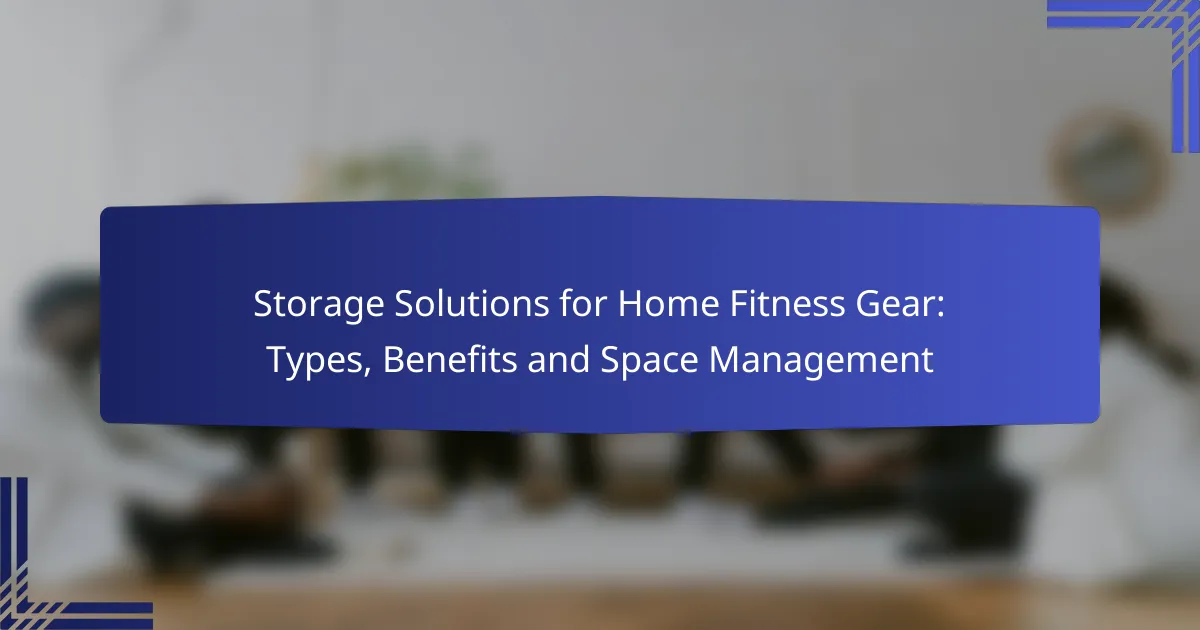Creating an organized and efficient space for home fitness gear is essential for maintaining a clutter-free workout environment. By utilizing various storage solutions such as wall-mounted racks, storage bins, and multi-functional furniture, you can maximize your available space while ensuring easy access to your equipment. A well-planned storage system not only enhances organization but also promotes safety and encourages regular exercise.

What are the best storage solutions for home fitness gear?
The best storage solutions for home fitness gear include wall-mounted racks, storage bins, multi-functional furniture, over-the-door organizers, and rolling carts. Each option offers unique benefits for maximizing space and keeping equipment organized, making it easier to maintain a clutter-free workout environment.
Wall-mounted racks
Wall-mounted racks are an efficient way to store fitness gear while saving floor space. They can hold items like weights, resistance bands, and yoga mats, keeping them accessible yet out of the way. When selecting a rack, ensure it can support the weight of your equipment and fits your wall space.
Consider installing racks at a height that allows easy access without straining. Look for adjustable options to accommodate various gear sizes. Proper installation is crucial; use appropriate anchors for your wall type to prevent accidents.
Storage bins
Storage bins are versatile and can be used to organize smaller fitness items such as bands, gloves, and towels. They come in various sizes and materials, making it easy to find options that fit your space and aesthetic. Clear bins can help you quickly identify contents, while labeled bins enhance organization.
Choose stackable bins to maximize vertical space. Ensure bins are durable and easy to clean, especially if they will hold sweaty gear. Regularly declutter and assess what you truly need to keep your storage efficient.
Multi-functional furniture
Multi-functional furniture serves dual purposes, such as a bench that doubles as storage for weights or mats. This type of furniture is ideal for small spaces, allowing you to combine functionality with style. Look for pieces that blend with your home decor while providing ample storage.
When selecting multi-functional furniture, consider the weight capacity and ease of access to stored items. Ensure that the furniture is sturdy enough for workouts and that it complements your overall fitness setup.
Over-the-door organizers
Over-the-door organizers are excellent for utilizing otherwise wasted space, perfect for storing items like jump ropes, small weights, or towels. These organizers can be hung on doors in your workout area or even in closets, keeping gear accessible without taking up floor space.
Choose organizers with pockets or hooks that can accommodate various item sizes. Ensure the door can support the weight of the organizer and its contents. Regularly check for wear and tear to maintain safety and functionality.
Rolling carts
Rolling carts provide a mobile storage solution for fitness gear, allowing you to easily move equipment where you need it. They are particularly useful for larger items like kettlebells or foam rollers and can be tucked away when not in use. Look for carts with sturdy wheels that lock in place for stability during workouts.
Consider the size and weight capacity of the cart to ensure it meets your storage needs. Use baskets or bins on the cart to keep smaller items organized. Regularly clean the cart to prevent dust accumulation and maintain a tidy workout space.

How do I choose the right storage solution?
Choosing the right storage solution for home fitness gear involves assessing your available space, considering the types of equipment you own, and evaluating how easily you need to access your gear. A well-planned storage system can help keep your workout area organized and efficient.
Assess available space
Start by measuring the area where you plan to store your fitness gear. Consider both floor space and vertical space, as utilizing wall-mounted options can maximize storage without taking up valuable floor area. Aim for a layout that allows for easy movement around your equipment.
Identify any existing furniture or fixtures that may impact your storage options. For example, if you have a small apartment, you might need to opt for multi-functional furniture that can serve as both storage and workout space.
Consider gear types
Different types of fitness equipment require different storage solutions. For larger items like treadmills or stationary bikes, dedicated floor space is essential, while smaller items like dumbbells or resistance bands can be stored in bins or on shelves. Make a list of your gear to determine what storage solutions will work best.
For example, if you have a variety of items, consider using a combination of open shelving for easy access and closed cabinets for less frequently used gear. This approach can help maintain a tidy appearance while keeping everything organized.
Evaluate accessibility needs
Think about how often you use each piece of equipment. Items you use daily should be easily accessible, while those used less frequently can be stored away. For instance, a wall-mounted rack for yoga mats can keep them off the floor while remaining within reach.
Additionally, consider the ease of retrieving items. Avoid stacking equipment too high or placing it in hard-to-reach areas, as this can lead to frustration and safety hazards. A well-organized system will encourage regular use and help maintain your fitness routine.

What are the benefits of effective storage for fitness gear?
Effective storage for fitness gear optimizes space, enhances organization, and promotes safety. By implementing smart storage solutions, you can create a more functional workout environment that encourages regular exercise and minimizes hazards.
Maximized space utilization
Maximizing space utilization means making the most of available areas in your home for storing fitness equipment. Consider vertical storage options like wall-mounted racks or shelves, which can free up floor space while keeping gear accessible.
Using multi-functional furniture, such as benches with built-in storage, can also help. Aim to keep frequently used items within easy reach, while less common gear can be stored in less accessible areas, ensuring efficient use of your space.
Improved organization
Improved organization helps you quickly find and access your fitness gear, making your workout routine more efficient. Categorize items by type, such as weights, resistance bands, and yoga mats, and store them in designated areas or containers.
Labeling storage bins or shelves can further enhance organization. Regularly assess your gear to remove items you no longer use, which can help maintain a tidy and efficient workout space.
Enhanced safety
Enhanced safety is crucial in a home fitness environment to prevent accidents and injuries. Proper storage reduces clutter, which can lead to tripping hazards. Ensure that heavier items are stored at lower heights to prevent injury when lifting.
Additionally, securing loose items and using storage solutions that keep equipment stable can prevent falls. Regularly check your storage setup to ensure it remains safe and functional, making adjustments as needed to accommodate new gear or changes in your workout routine.

What are popular brands for fitness storage solutions?
Popular brands for fitness storage solutions include IKEA, Rubbermaid, and ProForm, each offering unique products tailored to organizing home fitness gear. These brands provide a variety of options that cater to different needs, from space-saving bins to specialized racks.
IKEA storage options
IKEA is known for its versatile and affordable storage solutions, making it a favorite for fitness enthusiasts. Their products, such as the KALLAX shelving unit and various storage boxes, can be customized to fit different spaces and styles.
When selecting IKEA storage, consider the size and weight of your fitness gear. For example, using sturdy boxes or bins can help keep items like weights and resistance bands organized and easily accessible.
Rubbermaid bins
Rubbermaid offers durable storage bins that are ideal for organizing fitness equipment. Their bins come in various sizes and can be stacked, which is great for maximizing vertical space in a home gym.
Choose clear bins to easily see contents, or opt for colored bins for a more aesthetic appeal. Ensure the bins are labeled to quickly locate items, reducing clutter and saving time during workouts.
ProForm storage racks
ProForm specializes in fitness equipment and offers storage racks designed specifically for gym gear. These racks are sturdy and can hold various items, from weights to yoga mats, keeping everything neatly arranged.
When using ProForm racks, assess your available space and the types of equipment you own. A well-placed rack can enhance your workout area’s functionality, making it easier to maintain an organized environment.

How can I manage space for fitness gear in small homes?
Managing space for fitness gear in small homes involves utilizing creative storage solutions that maximize available areas. Prioritizing vertical space, compact shelving, and under-bed storage can help keep your equipment organized and accessible without cluttering your living space.
Vertical storage techniques
Vertical storage techniques are effective for utilizing wall space to store fitness gear. Consider installing wall-mounted racks or shelves to hold items like resistance bands, yoga mats, and weights. This approach keeps the floor clear and makes use of often-overlooked areas.
Another option is to use pegboards, which allow for customizable storage solutions. You can hang various types of equipment, making it easy to see and access your gear while keeping it organized.
Compact shelving units
Compact shelving units are ideal for small homes, offering a dedicated space for fitness gear without taking up too much room. Look for units that fit snugly in corners or narrow spaces, allowing you to store items like dumbbells, kettlebells, and foam rollers efficiently.
When selecting shelving, consider adjustable shelves to accommodate different sizes of equipment. This flexibility ensures you can maximize storage as your fitness needs evolve.
Under-bed storage solutions
Under-bed storage solutions can be a game-changer for small homes, providing a hidden space for fitness gear. Utilize storage bins or drawers designed to fit under your bed, which can hold items like yoga mats, resistance bands, or small weights.
Choose clear bins to easily identify contents or label them for quick access. This method keeps your gear out of sight while still being readily available when you need it, helping maintain a tidy living environment.

What are the costs associated with fitness gear storage solutions?
The costs of fitness gear storage solutions can vary widely based on the type and complexity of the system chosen. Basic options like shelving or bins can be quite affordable, while custom-built solutions or high-end furniture can reach several hundred dollars.
Types of storage solutions
Common types of fitness gear storage solutions include shelving units, storage bins, wall-mounted racks, and furniture designed for multi-purpose use. Shelving units are versatile and can hold various items, while bins help keep smaller equipment organized and out of sight. Wall-mounted racks save floor space and are ideal for items like bikes or resistance bands.
Benefits of proper storage
Proper storage of fitness gear enhances organization, making it easier to access equipment when needed. It also helps maintain a clean and safe environment, reducing the risk of accidents caused by clutter. Additionally, effective storage can prolong the life of your gear by protecting it from damage.
Space management tips
To manage space effectively, consider using vertical storage solutions to maximize available height. Utilize under-bed storage for items that are not frequently used, and categorize equipment by type or frequency of use. Regularly declutter and donate or sell items that are no longer needed to keep your space organized.
